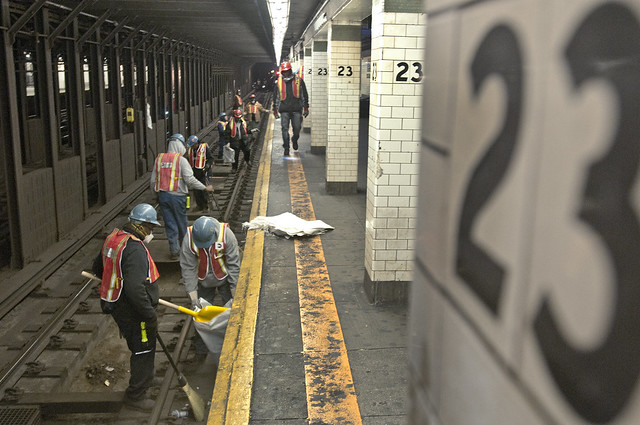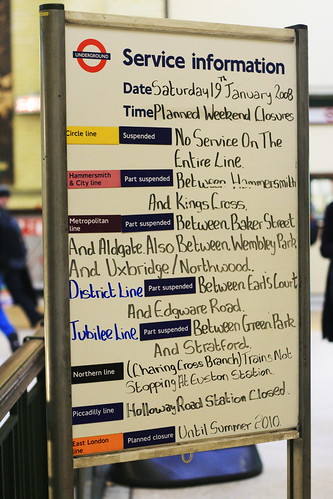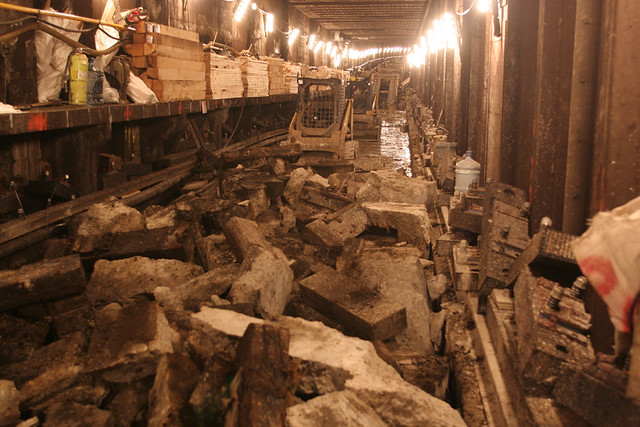
Workers at 23rd Street were able to give the track bed a thorough scrubbing with no trains zooming by. (Photo by Metropolitan Transportation Authority / Patrick Cashin)
“State of Good Repair” isn’t a term used much by the MTA these days. Half a decade ago, it was the nearly unattainable Holy Grail of the status of the city’s infrastructure. We had fancy new rolling stock, but the tracks, signals, switches, shops and stations weren’t up to par. A never-ending cycle of multi-decade investment and work was designed to bring the system into a state of good repair, but as Transit came to learn the Sisyphean nature of their quest, the phrase slowly left the MTA lexicon.
This week, New York City Transit debuted its FastTrack program. For four nights — the last of which is tonight — from 10 p.m. to 5 a.m., there is no service along the East Side IRT from Grand Central to Atlantic Ave. as work crews blitz the stations along that route. In a few weeks, the West Side lines will undergo a similar experience as the authority is piloting with a potential once-a-quarter plan to spiffy up the subways.
The origins of this idea remain a bit hazy. Jay Walder had spoken of full line shut-downs as early as May of 2010, and the MTA finally unveiled the current iteration of its FastTrack plan in mid-November. At the time, the authority explained that it could save at least $10-$15 million doing this week all at once rather than piecemeal over night and during weekends.
At the time, it was kinda sorta billed as an alternative to weekend work, but that was seemingly an optimistic interpretation of the MTA’s plans. They had always maintained that weekend work would go on as planned; after all, the capital investment projects never end. But by shutting the stations for a few days, they can get much-needed repairs out of the way quicker and more efficiently than they otherwise would. “This is not a replacement for weekend work,” Transit spokesman Kevin Ortiz clarified to me earlier this week. It does though add up to more inconvenience for many over the course of the week on top of endless weekend diversions.
Overall, the the MTA says these closures impact around 10-15 percent of the 250,000 people who ride the subway each weeknight, and so far, things have gone off smoothly. While a few newspaper reporters drummed up some ill-informed and irate straphangers and Transportation Nation ran a hilariously self-aware series of photo interviews with a balance of viewpoints, riders I’ve spoken with have found it annoying but hardly Earth-shattering. As New York’s subways enjoy an abundance of redundant service, most have found easy alternate routes to connect from Manhattan to Brooklyn. One compared this work to alternate side parking: It just happens, we deal with it and it’s not a major life event.
So what exactly is the MTA doing as they inconvenience 25,000 every weeknight? According to authority’s materials, crews have inspected repaired signals and switches and have replaced third-rail defects. They have cleaned stations, repaired broken tiles and replaced light bulbs. They have cleared the tracks of litter, debris and mud. They have repaired platform edges at various stations and have installed ADA warning strips at others. These aren’t particularly sexy repairs, but station components will look and work better because of it.
Yet, I can’t help but think that we shouldn’t need to cut off all service to make these repairs. Some of the track work requires shut downs, and concentrated access to the tracks requires alternate routing. Yet, by allowing the system to deteriorate, the MTA is forced to fast track its repairs. We still have a 24-hour system, and the MTA has always faced neighborhood opposition when it has threatened to shutter stations and reroute trains during the wee hours of the night. Here we are, though, with less weekend night service for 16 weeks a year. We still won’t enjoy that state of good repair.




